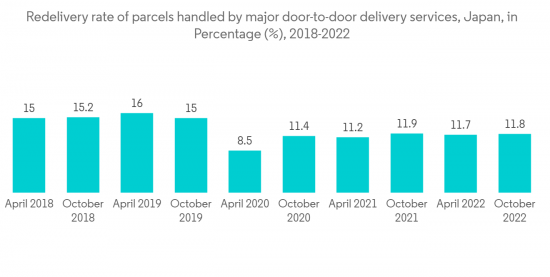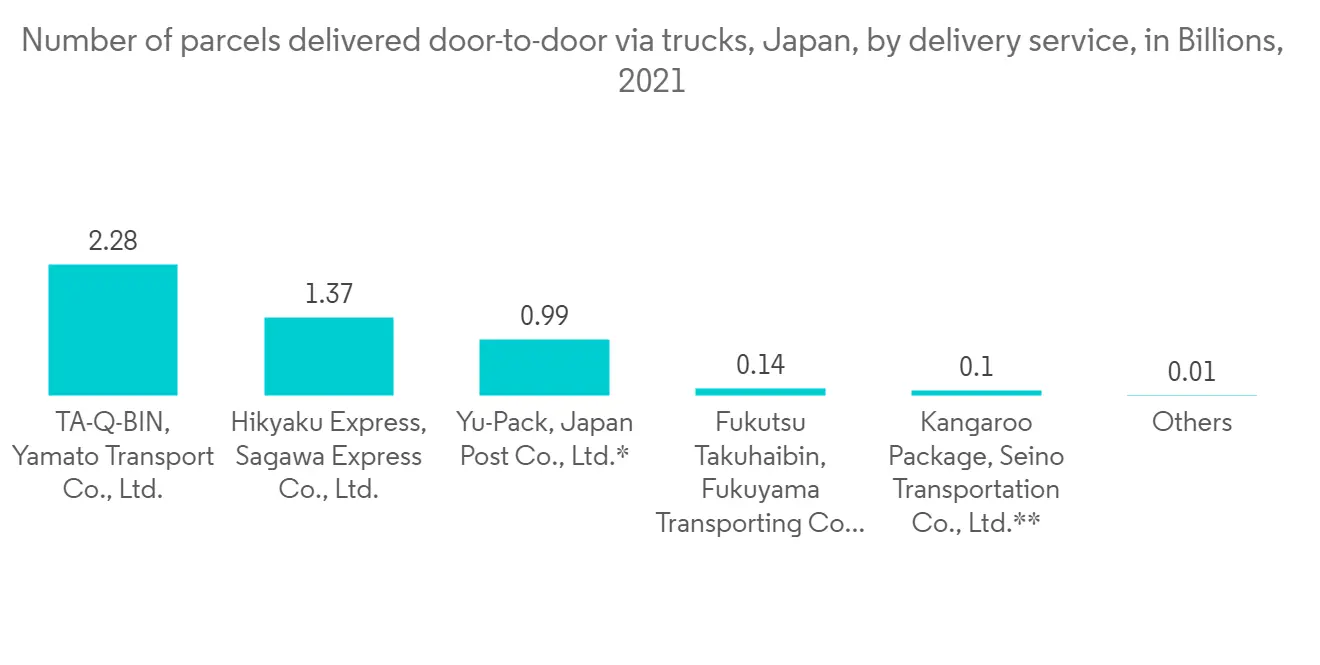PUBLISHER: Mordor Intelligence | PRODUCT CODE: 1334479

PUBLISHER: Mordor Intelligence | PRODUCT CODE: 1334479
Japan Courier, Express, and Parcel (CEP) Market Size & Share Analysis - Growth Trends & Forecasts (2023 - 2028)
The Japan Courier, Express, and Parcel (CEP) Market size is estimated at USD 20.31 billion in 2023, and is expected to reach USD 37.88 billion by 2028, growing at a CAGR of 13.28% during the forecast period (2023-2028).
The quick delivery of high-quality goods across the nation is what drives the market. Furthermore, the use of cutting-edge technology in warehouses and product delivery to the last mile drives the market.
Key Highlights
- When it comes to last-mile logistics, the impact of this outlook on Japan's delivery agents is concerning. As long as coronavirus outbreaks keep happening, online delivery will stay popular, and delivery agents will be under more and more pressure to make deliveries on time. The country also has high standards for customer service and hospitality, so even small delays in delivery are noticed by customers. It's not surprising that Japanese delivery drivers have formed a union to protest being overworked.Workers in Yokosuka, Kanagawa Prefecture, said they had been overworked to the point of exhaustion at a press conference in Tokyo. Japan's population is falling, which has been a problem for a long time. It has put a cloud over the country's economy and could hurt it.The pandemic also caused a big drop in the number of foreign workers, which has made the shortage even worse.
- Speed of delivery is an important factor for Japanese shoppers, and one-day shipping is almost always the norm.Because of the country's size and the presence of an efficient logistics sector, deliveries can be made much faster and more efficiently. One interesting thing about Japanese customers is that they prefer to get their packages from the delivery driver instead of leaving them at the door.Studies show that Japanese buyers are less likely than buyers in other countries to buy from foreign markets, and there is a clear preference for delivery services within Japan.In the absence of this option, a reputable delivery service should suffice. Buyers consciousness of quality is consistently greater than their concern for the cost.
- Players focus on making software that provides an analytics platform in real time and manages the flow of products and information across the network of the supply chain. The software is meant to make a company's supply chain operations better and stronger by managing production, inventory, sourcing, transportation, and monitoring product demand. It can be changed to fit the needs of the company, and its subcategories include supply chain planning, transportation management systems (TMS), warehouse management systems (WMS), manufacturing execution systems, and others. Players are focusing on adopting emerging technologies such as AI, ML, and big data. The use of artificial intelligence has simplified the development of more efficient, advantageous, and dependable processes. Technology such as the Internet of Things (IoT) aids in the maintenance of a transparent supply chain network, which in turn helps bring customer visibility, loyalty, and trust.
Japan CEP Market Trends
Growth in domestic courier and parcel services driving the market
Over the last two decades, Japan's distribution channels have been significantly consolidated. Consumer goods and industrial products have very different distribution channels. Small retail stores have been and continue to be dominant points of consumer sales due to limited space and dense urban populations. As a result, retailers frequently stock limited quantities of a product, and wholesalers are required to deliver small amounts of a product more frequently. This system is maintained by the Japanese cultural preference for doing business face-to-face, as well as loyalty or a sense of obligation in relationships, but the costs of this less efficient distribution system are passed on to the consumer in the final price of the product. The expansion of suburban "big box" retailers and e-commerce is posing a threat to this model.
Even before the pandemic drove more people to prefer online shopping over brick-and-mortar (something many people thought unlikely for older demographics given the country's love affair with local shops and cash payments), Japanese e-commerce growth has been staggering over the last decade. Japan has a high density of small local stores and markets located throughout any urban city-a result of the average Japanese household's lack of space, which prevents many families from stocking up on products in large quantities and forces them to visit nearby shops for essentials on an almost daily basis. With their extensive distribution and delivery networks, major e-commerce platforms such as Amazon and Rakuten have made significant gains in recent years.

Increase in demand for last-mile services driving the market
Japan has an incredibly strong service culture, which revolves around home delivery in the last mile. About 99% of all packages are sent to homes, and the delivery person can try up to four times.With a 20% failure rate, this comes at a high cost to carriers, a cost that is only expected to rise as parcel volumes increase. According to the WEF, e-commerce volumes in central Tokyo's 23 wards will increase by 85% by 2030. Because of this, the number of delivery vehicles needed is expected to go up by 71%, and each vehicle will have to go 25% further. This will increase traffic and carbon emissions by a lot.This increase will also affect suburban areas. To meet the demand, delivery fleets are expected to grow by 51%.
With fewer working-age drivers to fill open positions and an aging population, Japan may struggle to meet the increasing demand for home deliveries. Surprisingly, Japan already has a large out-of-home delivery network in place. Yamato, Japan's largest parcel carrier, for example, has over 250,000 TA-Q-BIN collection points in desirable and convenient locations. In Tokyo, 95% of residents are within a 5-minute walk of a Yamato locker. These points, however, are primarily used for outgoing C2C parcels. Japanese residents use this service not only to send parcels to others but also to send parcels to themselves for easier travel. A customer, for example, may ship their luggage for a trip directly to a hotel or even ship golf clubs to the course the day before their visit to avoid traveling with these items.
Until recently, all of these collection and sending points used paper-based manual processes, which was time-consuming and annoying for customers. Yamato has now seen the chance to make this experience digital and make full use of its impressive network, which is in line with its Next100 plan. Yamato collaborated with Doddle to license our PUDO application to digitize and speed up the in-store process, which includes features like label printing, parcel organization for storage, quick collection, and digital receipts. This service will be rolled out to 8,000 stores and is a key component of Yamato's Next100 strategy to increase volume into OOH, provide a high-quality customer experience across all e-commerce channels, and relieve pressure on home delivery.

Japan CEP Industry Overview
The Japan courier, express, and parcel (CEP) market is fragmented and highly competitive, with a few players occupying the majority of the international CEP market. The market is fragmented, and it is expected to grow during the forecast. The major players in Japan's CEP market are Japan Post, Yamato, and Sagawa Express. Order fulfillment and the use of advanced technology have become major factors segregating big players in the market. On-time and fast delivery are the prerequisites for every customer demanding these services at their places of business.
Additional Benefits:
- The market estimate (ME) sheet in Excel format
- 3 months of analyst support
TABLE OF CONTENTS
1 INTRODUCTION
- 1.1 Study Assumptions
- 1.2 Scope of the Study
2 RESEARCH METHODOLOGY
- 2.1 Analysis Methodology
- 2.2 Research Phases
3 EXECUTIVE SUMMARY
4 MARKET INSIGHTS
- 4.1 Current Market Scenario
- 4.2 Technological Trends
- 4.3 Government Regulations
- 4.4 Value Chain / Supply Chain Analysis
- 4.5 Overview of Logistics and Warehousing Market in Japan
- 4.6 Brief on Freight Rates (average.cost per parcel for domestic and international transport, trends, etc.)
- 4.7 Insights on Supply Chain/Value Chain Analysis of the CEP Market
- 4.8 Spotlight on 3PL Market in Japan
- 4.9 Insights on Reverse Logistics
- 4.10 Impact of COVID-19 on the CEP Market (short-term and long-term effects on the market, as well as economy)
5 MARKET DYNAMICS
- 5.1 Drivers
- 5.2 Restraints
- 5.3 Opportunitites
- 5.4 Porter's Five Forces Analysis
- 5.4.1 Bargaining Power of Suppliers
- 5.4.2 Bargaining Power of Consumers / Buyers
- 5.4.3 Threat of New Entrants
- 5.4.4 Threat of Substitute Products
- 5.4.5 Intensity of Competitive Rivalry
6 MARKET SEGMENTATION
- 6.1 By Destination
- 6.1.1 Domestic
- 6.1.2 International
- 6.2 By Business
- 6.2.1 B2B (Business-to-Business)
- 6.2.2 B2C (Business-to-Consumer)
- 6.3 By End-User
- 6.3.1 Services (includes BFSI (Banking, Financial Services and Insurance), etc.)
- 6.3.2 Wholesale and Retail Trade (including E-commerce)
- 6.3.3 Life Sciences/ Healthcare
- 6.3.4 Industrial manufacturing
- 6.3.5 Other End-Users
7 COMPETITIVE LANDSCAPE
- 7.1 Overview (Market Concentration and Major Players)
- 7.2 Company Profiles
- 7.2.1 Yamato
- 7.2.2 Sagawa Express
- 7.2.3 Japan Post
- 7.2.4 Seino Transportation
- 7.2.5 United Parcel Service
- 7.2.6 FedEx
- 7.2.7 DHL
- 7.2.8 Takuhai
- 7.2.9 TNT Express
- 7.2.10 Nippon Express Company
- 7.2.11 National Air Cargo *
8 MARKET OPPORTUNITIES AND FUTURE TRENDS
9 APPENDIX
- 9.1 Marcroeconomic Indicators (GDP breakdown by sector, Contribution of construction to economy, etc.)
- 9.2 Insights on Capital Flows (Investments in the Transport and Storage Sector)
- 9.3 E-commerce and Consumer Spending-related Statistics
- 9.4 External Trade Statistics - Export and Import, by Product and Country
- 9.5 Demographics of Japan (Total Population, Population Breakdown by Age, Gender, City/Region, etc.)




